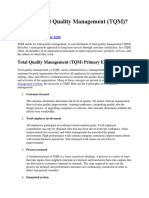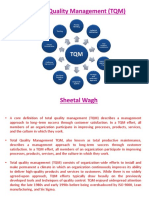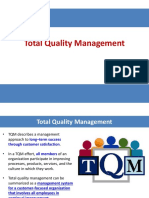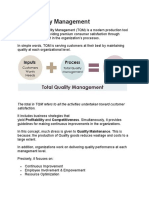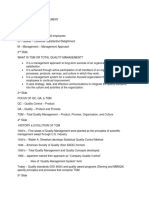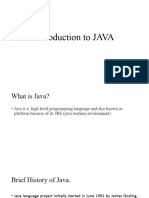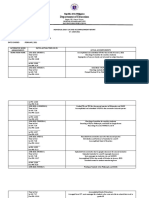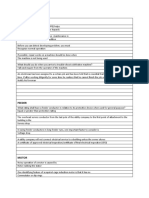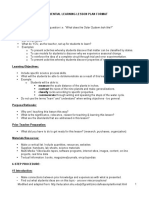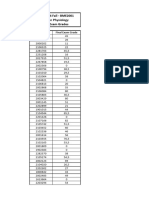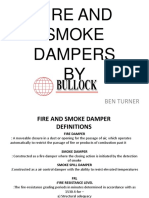0 ratings0% found this document useful (0 votes)
42 viewsTotal Quality Management By: Mohamed Ayman Abdallah Student in The Faculty of Nursing, Beni Suef National University 2023
Total Quality Management By: Mohamed Ayman Abdallah Student in The Faculty of Nursing, Beni Suef National University 2023
Uploaded by
Mohamed AymanThis document outlines the key concepts of total quality management (TQM). It defines TQM as a management approach focused on long-term customer satisfaction through company-wide participation in continuous process improvement. The primary elements of TQM include customer focus, employee involvement, a process-centered approach, and an integrated system. Some benefits are strengthened competitiveness, higher productivity, and improved customer satisfaction. The document also discusses implementing TQM systems and factors that can lead to failures, such as inadequate resources or lack of management support.
Copyright:
© All Rights Reserved
Available Formats
Download as DOCX, PDF, TXT or read online from Scribd
Total Quality Management By: Mohamed Ayman Abdallah Student in The Faculty of Nursing, Beni Suef National University 2023
Total Quality Management By: Mohamed Ayman Abdallah Student in The Faculty of Nursing, Beni Suef National University 2023
Uploaded by
Mohamed Ayman0 ratings0% found this document useful (0 votes)
42 views18 pagesThis document outlines the key concepts of total quality management (TQM). It defines TQM as a management approach focused on long-term customer satisfaction through company-wide participation in continuous process improvement. The primary elements of TQM include customer focus, employee involvement, a process-centered approach, and an integrated system. Some benefits are strengthened competitiveness, higher productivity, and improved customer satisfaction. The document also discusses implementing TQM systems and factors that can lead to failures, such as inadequate resources or lack of management support.
Original Title
Untitled
Copyright
© © All Rights Reserved
Available Formats
DOCX, PDF, TXT or read online from Scribd
Share this document
Did you find this document useful?
Is this content inappropriate?
This document outlines the key concepts of total quality management (TQM). It defines TQM as a management approach focused on long-term customer satisfaction through company-wide participation in continuous process improvement. The primary elements of TQM include customer focus, employee involvement, a process-centered approach, and an integrated system. Some benefits are strengthened competitiveness, higher productivity, and improved customer satisfaction. The document also discusses implementing TQM systems and factors that can lead to failures, such as inadequate resources or lack of management support.
Copyright:
© All Rights Reserved
Available Formats
Download as DOCX, PDF, TXT or read online from Scribd
Download as docx, pdf, or txt
0 ratings0% found this document useful (0 votes)
42 views18 pagesTotal Quality Management By: Mohamed Ayman Abdallah Student in The Faculty of Nursing, Beni Suef National University 2023
Total Quality Management By: Mohamed Ayman Abdallah Student in The Faculty of Nursing, Beni Suef National University 2023
Uploaded by
Mohamed AymanThis document outlines the key concepts of total quality management (TQM). It defines TQM as a management approach focused on long-term customer satisfaction through company-wide participation in continuous process improvement. The primary elements of TQM include customer focus, employee involvement, a process-centered approach, and an integrated system. Some benefits are strengthened competitiveness, higher productivity, and improved customer satisfaction. The document also discusses implementing TQM systems and factors that can lead to failures, such as inadequate resources or lack of management support.
Copyright:
© All Rights Reserved
Available Formats
Download as DOCX, PDF, TXT or read online from Scribd
Download as docx, pdf, or txt
You are on page 1of 18
Total quality management
By: Mohamed Ayman Abdallah
Student in the Faculty of
Nursing, Beni Suef National
University 2023
Under supervision: Prof./
Salwa Ahmed
Outlines:
1) Definition of TQM
2) PRIMARY ELEMENTS &
PRINCIPLES OF TQM
3) BENEFITS OF TOTAL
QUALITY MANAGEMENT
4) TQM
IMPLEMENTATION AND
SYSTEMS
5) FACTOR LEADING TO
FAILURE IN TQM
Definition of total quality
management:
A core definition of total quality
management (TQM) describes a
management approach to long-term
success through customer
satisfaction. In a TQM effort, all
members of an organization
participate in improving processes,
products, services, and the culture in
which they work. ..
PRIMARY ELEMENTS &
PRINCIPLES OF TQM:
TQM can be summarized as
a management system for a
customer-focused
organization that involves all
employees in continual
improvement. It uses
strategy, data, and effective
communications to
integrate the quality
discipline into the
culture ,the successor to
TQM. Here are the 8
principles of total quality
management:
1. Customer-focused: The
customer ultimately determines the
level of quality. No matter what an
organization does to foster
quality improvement—training empl
oyees, integrating quality into the
design process, or upgrading
computers or software—the
customer determines whether the
efforts were worthwhile.
2. Total employee
involvement: All employees
participate in working toward
common goals. Total employee
commitment can only be obtained
after fear has been driven from the
workplace, when empowerment has
occurred, and when management
has provided the proper
environment. High-performance
work systems integrate continuous
improvement efforts with normal
business operations. Self-managed
work teams are one form of
empowerment.
3. Process-centered: A
fundamental part of TQM is a focus
on process thinking. A process is a
series of steps that take inputs from
suppliers (internal or external) and
transforms them into outputs that
are delivered to customers (internal
or external). The steps required to
carry out the process are defined,
and performance measures are
continuously monitored in order to
detect unexpected variation.
4. Integrated system: Although an
organization may consist of many
different functional specialties often
organized into vertically structured
departments, it is the horizontal
processes interconnecting these
functions that are the focus of TQM.
1) Micro-processes add up to
larger processes, and all
processes aggregate into the
business processes required for
defining and implementing
strategy. Everyone must
understand the vision, mission,
and guiding principles as well as
the quality policies, objectives,
and critical processes of the
organization. Business
performance must be monitored
and communicated continuously.
2) An integrated business
system may be modeled after
the Baldrige Award criteria
and/or incorporate the ISO 9000
standards. Every organization
has a unique work culture, and it
is virtually impossible to achieve
excellence in its products and
services unless a good quality
culture has been fostered. Thus,
an integrated system connects
business improvement elements
in an attempt to continually
improve and exceed the
expectations of customers,
employees, and other
stakeholders.
5. Strategic and systematic
approach: A critical part of the
management of quality is the
strategic and systematic approach
to achieving an organization’s
vision, mission, and goals. This
process, called strategic planning or
strategic management, includes the
formulation of a strategic plan that
integrates quality as a core
component.
6. Continual improvement: A
large aspect of TQM is continual
process improvement. Continual
improvement drives an organization
to be both analytical and creative in
finding ways to become more
competitive and more effective at
meeting stakeholder expectations.
7. Fact-based decision
making: In order to know how well
an organization is performing, data
on performance measures are
necessary. TQM requires that an
organization continually collect and
analyze data in order to improve
decision making accuracy, achieve
consensus, and allow prediction
based on past history.
8 . Communications: During times
of organizational change, as well as
part of day-to-day operation, effective
communications plays a large part in
maintaining morale and in motivating
employees at all levels.
Communications involve strategies,
method, and timeliness.
BENEFITS OF TOTAL
QUALITY MANAGEMENT:
1. Strengthened competitive position
2. Adaptability to changing or emerging
market conditions and to
environmental and other government
regulations
3. Higher productivity
4. Enhanced market image
5. Elimination of defects and waste
6. Reduced costs and better cost
management
7. Higher profitability
8. Improved customer focus and
satisfaction
9. Increased customer loyalty and
retention
10. Increased job security
11. Improved employee morale
12. Enhanced shareholder and
stakeholder value
13. Improved and innovative
processes
TQM implementation and
systems:
When planning and implementing a
total quality management system or
quality management strategy, there is
no one solution for every situation or
workplace.
Each organization is unique in terms of
the culture, management practices,
and the processes used to create and
deliver its products and services.
Quality management strategy vary
from organization to organization;
however, a set of primary elements
should be present in some format.
General strategy model for the
implementation of total quality
management systems:
1) Top management learns about and
decides to commit to TQM. TQM is
identified as one of the organization’s
strategies.
2) The organization assesses current
culture, customer satisfaction, and
quality management systems.
3) Top management identifies core
values and principles to be used, and
communicates them.
4) A TQM master plan is developed on
the basis of steps 1, 2, and 3.
5) The organization identifies and
prioritizes customer demands and
aligns products and services to meet
those demands.
6) Management maps the critical
processes through which the
organization meets its customers’
needs.
7) Management oversees the
formation of teams for process
improvement efforts
8) The momentum of the TQM effort is
managed by the steering committee.
9) Managers contribute individually to
the effort through hoshin planning,
training, coaching, or other methods.
10)Daily process management and
standardization take place.
11)Progress is evaluated and the plan is
revised as needed.
12)Constant employee awareness and
feedback on status are provided and a
rewar
Factors leading to failure in
total quality management:
There are both theoretical and practical
difficulties in applying TQM in
organisations.
And they are as follows:
1) Ineffective TQM package,
inappropriate TQM plan.
2) Inappropriate
environment.
3) Insufficient education and
training.
4) lack of employees.
5) lack of top management
support.
6) inadequate resources
7) deficient leadership
8) lack of a quality-oriented
culture,
9) poor communication
10) lack of a plan for
change and employee
resistance to the change
programme.
You might also like
- Bringing Quality Principles To Life at Karlee Case Study Presented by Group 3Document5 pagesBringing Quality Principles To Life at Karlee Case Study Presented by Group 3boyoo holics33% (3)
- SynthesisDocument38 pagesSynthesisDevina Gomez Toripil100% (1)
- Total Quality Management (TQM)Document35 pagesTotal Quality Management (TQM)cyndrellaNo ratings yet
- Total Quality ManagementDocument2 pagesTotal Quality Managementclumsy16No ratings yet
- Total Quality Management (TQM)Document31 pagesTotal Quality Management (TQM)malathi100% (1)
- Total Quality ManagementDocument2 pagesTotal Quality Managementkaushikbose81No ratings yet
- Operations Management PocketBook 2Document17 pagesOperations Management PocketBook 2Miteshwar ManglaniNo ratings yet
- What Is Total Quality Management TQMDocument15 pagesWhat Is Total Quality Management TQMmariel andayaNo ratings yet
- Class Notes TQMDocument12 pagesClass Notes TQMNext Level LivingNo ratings yet
- THOUGHT CHPTER SEVEN ThoughtDocument24 pagesTHOUGHT CHPTER SEVEN ThoughtJulianNo ratings yet
- Customer-Focused:: Empowerment Continuous Improvement TeamsDocument7 pagesCustomer-Focused:: Empowerment Continuous Improvement TeamsAie GeraldinoNo ratings yet
- TQM, Principles EtcDocument6 pagesTQM, Principles EtcAumNo ratings yet
- Total Quality Management (Quản Lý Chất Lượng Toàn Diện)Document2 pagesTotal Quality Management (Quản Lý Chất Lượng Toàn Diện)Duy TrácNo ratings yet
- Total Quality Management PG QP DEC 2023.revised 4yehtPbBCJDocument5 pagesTotal Quality Management PG QP DEC 2023.revised 4yehtPbBCJroman reignsNo ratings yet
- Total Quality ManagementDocument68 pagesTotal Quality ManagementaffanNo ratings yet
- Assignment SEQDocument13 pagesAssignment SEQVicky KdNo ratings yet
- Amended MGT702 Major Project 2021Document23 pagesAmended MGT702 Major Project 2021kajal prasadNo ratings yet
- Unit 6 - Qulaity Assurance - Lecture 7Document18 pagesUnit 6 - Qulaity Assurance - Lecture 7Ababab AbabNo ratings yet
- Total Quality ManagementDocument10 pagesTotal Quality ManagementJamel torresNo ratings yet
- Total Quality ManagementDocument7 pagesTotal Quality ManagementManoj AgarwalNo ratings yet
- TQM Unit-IDocument19 pagesTQM Unit-IKalyan NaniNo ratings yet
- 18.total Quality ManagementDocument4 pages18.total Quality ManagementmercatuzNo ratings yet
- Kmbn205 Unit 5Document26 pagesKmbn205 Unit 5akshitbhardwaj790No ratings yet
- Bureaucratic System Nowadays in Fact, Is More Fluid and Less Hierarchical Forms of OrganisationDocument5 pagesBureaucratic System Nowadays in Fact, Is More Fluid and Less Hierarchical Forms of OrganisationLâm NgânNo ratings yet
- Total Quality ManagamentDocument8 pagesTotal Quality ManagamentJoshua Jasmin GrospeNo ratings yet
- Total Quality ManagementDocument14 pagesTotal Quality ManagementNaseem AbbasNo ratings yet
- Definition of Total Quality Management (TQM)Document6 pagesDefinition of Total Quality Management (TQM)Tamizha Tamizha100% (1)
- Concepts of Total Quality ManagementDocument4 pagesConcepts of Total Quality ManagementJethrine Ann Tomas PasianNo ratings yet
- Novemberdecember 2011Document14 pagesNovemberdecember 2011Priyadharshni SelvarajNo ratings yet
- TQMDocument2 pagesTQMchristinemariecabilin122303No ratings yet
- Kmbn205 Unit 5Document27 pagesKmbn205 Unit 5akshitbhardwaj790No ratings yet
- Total Quality Management Model 2Document9 pagesTotal Quality Management Model 2bbit671j2020No ratings yet
- Otqm SC Finals2023Document4 pagesOtqm SC Finals2023cristobal.jeromeNo ratings yet
- Quality Systems Organizing and Implementation Report DiscussionDocument10 pagesQuality Systems Organizing and Implementation Report DiscussionLowlaa LowlaaNo ratings yet
- SIx Sigma ReportDocument7 pagesSIx Sigma ReportmukulNo ratings yet
- IQC CH 6Document16 pagesIQC CH 6AKSHIT 12No ratings yet
- Quality Control Lecture 3 & 4Document45 pagesQuality Control Lecture 3 & 4Turyamusiima CleverNo ratings yet
- Module 1 Notes - 18ME734.Document17 pagesModule 1 Notes - 18ME734.SANTOSH0% (1)
- Sanchez, N.-3BSOA4-BMC1 ACTIVITY4Document5 pagesSanchez, N.-3BSOA4-BMC1 ACTIVITY4Ava AbrahamNo ratings yet
- Module 3 - Lesson 2Document21 pagesModule 3 - Lesson 2John rigor AcostaNo ratings yet
- What Is Total Quality Management (TQM) ?Document4 pagesWhat Is Total Quality Management (TQM) ?Phamya ShreeNo ratings yet
- TQM (Total Quality Management) : 1. Customer FocusDocument5 pagesTQM (Total Quality Management) : 1. Customer FocusmpatroNo ratings yet
- TOTAL QUALITY MANAGMENT NEW Revised 15-11-2020Document22 pagesTOTAL QUALITY MANAGMENT NEW Revised 15-11-2020Mohammad AljarrahNo ratings yet
- MBS 8117 Total Quality Management and PerformanceDocument7 pagesMBS 8117 Total Quality Management and Performancemafabi gilbertNo ratings yet
- TQM Unit IiiDocument32 pagesTQM Unit Iiicirak50230No ratings yet
- Lesson One Introduction To TQMDocument21 pagesLesson One Introduction To TQMNelly MuseiNo ratings yet
- Total Quality ManagementDocument9 pagesTotal Quality ManagementEvanjo NuquiNo ratings yet
- August 20Document23 pagesAugust 20Barda, Jenny BabeNo ratings yet
- TQM 01Document9 pagesTQM 01Md Rabbi KhanNo ratings yet
- المحاضرة الثانيةDocument20 pagesالمحاضرة الثانيةa.abdeewi99No ratings yet
- QA - QC ManualDocument25 pagesQA - QC ManualMuhammad Bilal MughalNo ratings yet
- Semifinals 2Document12 pagesSemifinals 2Lory Grace TorresNo ratings yet
- Total Quality Management Is A Journey of Going From Where A Business and ItsDocument4 pagesTotal Quality Management Is A Journey of Going From Where A Business and ItsKrisha Ann RosalesNo ratings yet
- Intro To TQMDocument4 pagesIntro To TQMAlyssa PuentespinaNo ratings yet
- Total Quality ManagementDocument4 pagesTotal Quality ManagementJake CanlasNo ratings yet
- Quality and Business Process ReDocument19 pagesQuality and Business Process ReasvanmalindiNo ratings yet
- Final Assignment PMQDocument13 pagesFinal Assignment PMQDang Mai PhuongNo ratings yet
- I - Introduction Total Quality Management (TQM) Is A Comprehensive Management Approach That Originated inDocument6 pagesI - Introduction Total Quality Management (TQM) Is A Comprehensive Management Approach That Originated inJennelyn Saupi BantalaNo ratings yet
- Balanced Score Card:: Performance ManagementDocument4 pagesBalanced Score Card:: Performance Managementtappu0410No ratings yet
- Introduction of JAVADocument12 pagesIntroduction of JAVARahul SinghNo ratings yet
- Accomplishment Report February, 2021Document6 pagesAccomplishment Report February, 2021Juna Silawan Babatu-onNo ratings yet
- Solving Problems (Lecture 23B)Document6 pagesSolving Problems (Lecture 23B)Suraj sssNo ratings yet
- A Stability Analysis On Models of Cooperative and Competitive SpeciesDocument7 pagesA Stability Analysis On Models of Cooperative and Competitive SpeciesHerald MulanoNo ratings yet
- Catalogo ASCODocument4 pagesCatalogo ASCOIkaro MatosNo ratings yet
- Written TestDocument4 pagesWritten TestFERDINAND BANAGANo ratings yet
- Infosys PPT 13Document9 pagesInfosys PPT 13Durga Prasad SmartNo ratings yet
- Lesson 2 Activity RizalDocument3 pagesLesson 2 Activity RizalRachel Valenzuela0% (1)
- Anthropological Psychological Perspectives of The SelfDocument17 pagesAnthropological Psychological Perspectives of The SelfJomarieNo ratings yet
- St. Peter'S College: Third World LiteraturesyllabusDocument3 pagesSt. Peter'S College: Third World LiteraturesyllabusMary Jane Sebial ManceraNo ratings yet
- Advertisement Teaching Fellow Teaching Assistant 2022 NovDocument1 pageAdvertisement Teaching Fellow Teaching Assistant 2022 NovAhmad KamalNo ratings yet
- E3 Grammar Reference and Glossary With Intro in EnglishDocument18 pagesE3 Grammar Reference and Glossary With Intro in EnglishFabio Molinaris100% (1)
- NELC Learning Resource No.7Document70 pagesNELC Learning Resource No.7marylove llubitNo ratings yet
- LSPR UGP Thesis Manual 2021 - Revised EditionDocument146 pagesLSPR UGP Thesis Manual 2021 - Revised EditionAngelica FransiskaNo ratings yet
- Doc394972420 633553982fuihDocument18 pagesDoc394972420 633553982fuihLiz De Cereza100% (5)
- Des Lessonplan PDFDocument3 pagesDes Lessonplan PDFbabunaidu2006No ratings yet
- Acid Value - Metrohm Application Balletin No. 80-3 eDocument7 pagesAcid Value - Metrohm Application Balletin No. 80-3 e陳丹庭No ratings yet
- Chinese RevolutionDocument3 pagesChinese Revolutionhard02No ratings yet
- Basic Principles of Trauma ManagementDocument53 pagesBasic Principles of Trauma ManagementMohamed Saeed Bachoo100% (1)
- An Exegetical Commentary On The Gospel According To Saint Matthew - Plummer MADocument498 pagesAn Exegetical Commentary On The Gospel According To Saint Matthew - Plummer MAQuang HuỳnhNo ratings yet
- جبر الزمرDocument8 pagesجبر الزمرSadon B AsyNo ratings yet
- Quijano-Solis Carlos J 201511 PHD ThesisDocument198 pagesQuijano-Solis Carlos J 201511 PHD ThesisshanthakumargcNo ratings yet
- CH 10 Material Transport SystemsDocument57 pagesCH 10 Material Transport SystemsrazansamaemehNo ratings yet
- Final Exam GradesDocument4 pagesFinal Exam GradesHANI SbinatiNo ratings yet
- A Study On Mutual FundDocument66 pagesA Study On Mutual FundFaisal ArifNo ratings yet
- Average Time Middle Schoolers Spend On HomeworkDocument5 pagesAverage Time Middle Schoolers Spend On Homeworkafetuieog100% (1)
- GSK Pakistan Annual Report 2021Document44 pagesGSK Pakistan Annual Report 2021SaadNo ratings yet
- Ni 442 17Document3 pagesNi 442 17Mohamad AlwanNo ratings yet
- Architectures For Implementing Hil SystemDocument5 pagesArchitectures For Implementing Hil Systemsinq57No ratings yet
- Fire and Smoke Dampers BY: Ben TurnerDocument10 pagesFire and Smoke Dampers BY: Ben TurnerRolandNo ratings yet



